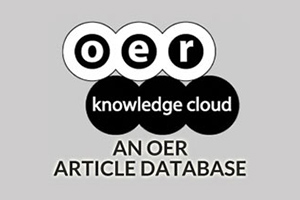The Relationship Between Learning Mode and Student Performance in an Undergraduate Elementary Statistics Course in the United States
DOI:
https://doi.org/10.19173/irrodl.v22i1.5033Keywords:
distance learning, online education, quality in higher education, student performance, grade distributionAbstract
Faculty have conducted many studies on the relationship between learning mode and student performance but few researchers have evaluated final grades, grade distribution, and pass rates in a sophomore introductory statistics course with a non-traditional student population who self-selected the learning mode from among different course sections. Accordingly, we examined 307 end-of-course grades from four different modes of instruction: (a) online, (b) videosynchronous learning classroom, (c) videosynchronous learning home, and (d) traditional classroom in an introductory statistics course. All data on grades, which included pass rate and grade distribution, were collected from the nine-week January 2019 term. All learning modes used the same text, syllabus, assignments, quizzes, and tests. In this study, learning mode was not significantly related to end-of-course score, final grade distribution, or pass rate. Future researchers should explore the impacts of gender, instructor quality, different term lengths, and the standardized use of textbooks and syllabi on student performance when exploring the impact of learning mode on grades, grade distribution, and pass rates.
Publication Facts
Reviewer profiles N/A
Author statements
- Academic society
- N/A
- Publisher
- Athabasca University Press
References
Atchley, T. W., Wingenbach, G., & Akers, C. (2013). Comparison of course completion and student performance through online and traditional courses. The International Review of Research in Open and Distributed Learning, 14(4). https://doi.org/10.19173/irrodl.v14i4.1461
Bourdeau, D., Griffith, K., Griffith, J. C., & Griffith J. R. (2018). An investigation of the relationship between grades and learning mode in an English composition course. Journal of University Teaching and Learning Practice, 15(2), 1-13. https://ro.uow.edu.au/cgi/viewcontent.cgi?article=1788&context=jutlp
Dotterweich, D. P., & Rochelle, C. F. (2012). Online, instructional television, and traditional delivery: Student characteristics and success factors in business statistics. American Journal of Business Education, 5(2), 129-138. https://doi.org/10.19030/ajbe.v5i2.6815
Flanagan, J. (2012). Online versus face-to-face instruction: Analysis of gender and course format in undergraduate business statistics courses. Academy of Business Research, II, 93-101. https://ssrn.com/abstract=2627101
Gay, L. R., Mills, G. E., & Airasian, P. W. (2009). Educational research: Competencies for analysis and application (9th ed.). Pearson.
Gould, R. N., & Ryan, C. N. (2012). Introductory statistics (1st ed.). Pearson.
Instructure. (2020). Canvas learning management system [Computer software]. Instructure. https://www.instructure.com/canvas/
Jaggars, S. S. (2014). Choosing between online and face-to-face courses: Community college student voices. American Journal of Distance Education, 28(1). http://dx.doi.org/10.1080/08923647.2014.867697
Jaggars, S. S., Edgecombe, N., & Stacey, G. W. (2013). What we know about online course outcomes (ED542143). ERIC. https://files.eric.ed.gov/fulltext/ED542143.pdf
Jahng, N., Krug, D., & Zhang, Z. (2007). Student achievement in online distance education compared to face-to-face education. European Journal of Open, Distance, and E-Learning, 10(1). https://core.ac.uk/download/pdf/24065525.pdf
Johnson, H. P., & Mejia, M. C. (2014, May). Online learning and student outcomes in California’s community colleges. Public Policy Institute of California. http://www.ppic.org/content/pubs/report/R_514HJR.pdf
Lawrence, J. A., & Singhania, R. P. (2004). A study of teaching and testing strategies for a required statistics course for undergraduate business students. Journal of Education for Business, 79(6), 333-338. https://doi.org/10.3200/JOEB.79.6.333-338
Lou, Y., Bernard, R. M., & Abrami, P. C. (2006). Media and pedagogy in undergraduate distance education: A theory-based meta-analysis of empirical literature. Educational Technology Research and Development, 54(2), 141-176. https://doi.org/10.1007/s11423-006-8252-x
Lundberg, J., Castillo-Merino, D., & Dahmani, M. (2008). Do online students perform better than face-to-face students? Reflections and a short review of some empirical findings. RUSE: Revista de Universidad y Sociedad del Conocimiento, 5(1), 35-43. https://pdfs.semanticscholar.org/f929/9785feccbe1cb20758d56912cf18f00ce1d4.pdf?_ga=2.79216084.1973320332.1607120314-1946193882.1607120314
McLaren, C. H. (2004). A comparison of student persistence and performance in online and classroom business statistics experiences. Decision Sciences Journal of Innovation, 2(1), 1-10. https://doi.org/10.1111/j.0011-7315.2004.00015.x
Means, B., Toyama, Y., Murphy, R., Bakia, M., & Jones, K. (2009). Evaluation of evidence-based practices in online learning: A meta-analysis and review of online learning studies. U.S. Department of Education. https://www2.ed.gov/rschstat/eval/tech/evidence-based-practices/finalreport.pdf
Murphy, C. A., & Stewart, J. C. (2017). On-campus students taking online courses: Factors associated with unsuccessful course completion. The Internet and Higher Education, 34, 1-9. https://doi.org/10.1016/j.iheduc.2017.03.001
Nguyen, T. (2015). The effectiveness of online learning: Beyond no significant difference and future horizons. Journal of Online Learning and Teaching, 11(2), 309-319. http://jolt.merlot.org/Vol11no2/Nguyen_0615.pdf
Online Learning Consortium. (2016, February 9). Babson study: Distance education enrollment growth continues. Online Learning Consortium. https://onlinelearningconsortium.org/news_item/babson-study-distance-education-enrollment-growth-continues-2/
Pearson. (2020). MyLabStat [Computer software]. Pearson. https://www.pearsonmylabandmastering.com/northamerica/mystatlab/
Roberts, D., Griffith, J., Faulconer, E., Wood, B., & Acharyya, S. (2019). An investigation of the relationship between grades and learning modes in an introductory research methods course. Online Journal of Distance Learning Administration, 22(1) 1-13. https://www.westga.edu/~distance/ojdla/spring221/roberts_griffith_faulconer_wood_acharyya221.html
Rochelle, C. F., & Dotterweich, D. (2007). Student success in business statistics. Journal of Economics, 6(1), 19-24. https://www.economics-finance.org/jefe/econ/Rochellepaper.pdf
Scherrer, C. R. (2011). Comparison of an introductory level undergraduate statistics course taught with traditional, hybrid, and online delivery methods. INFORMS Transactions on Education, 11(3), 106-110. https://doi.org/10.1287/ited.1110.0063
Shea, P., & Bidjerano, T. (2019). Effects of online course load on degree completion, transfer and dropout among community college students of the State University of New York. Online Learning, 23(4). https://doi.org/10.24059/olj.v23i4.1364
Shea, P., & Bidjerano, T. (2016). A national study of differences between distance and non-distance community college students in time to first associate degree attainment, transfer, and dropout. Online Learning, 20(3), 14-15. http://dx.doi.org/10.24059/olj.v23i4.1364
Sitzmann, T., Kraiger, K., Steward, D., & Wisher, R. (2006). The comparative effectiveness of web-based and classroom instruction: A meta-analysis. Personnel Psychology, 59(3), 623-664. https://doi.org/10.1111/j.1744-6570.2006.00049.x
Summers, J. J., Waigandt, A., & Whittaker, T. A. (2005). A comparison of student achievement and satisfaction in an online versus traditional face-to-face statistics class. Innovative Higher Education, 29(3), 233-250. https://doi.org/10.1007/s10755-005-1938-x
Triola, M. F. (2018). Elementary statistics: Using Excel (6th ed.). Pearson.
U.S. News and World Report. (2019). Embry-Riddle Aeronautical University. U.S. News and World Report: Best Colleges Rankings. https://www.usnews.com/best-colleges/embryriddle-aeronautical-university-1479
Williams, S. L. (2006). The effectiveness of distance education in allied health science programs: A meta-analysis of outcomes. American Journal of Distance Education, 20(3), 127-141. https://doi.org/10.1207/s15389286ajde2003_2
Xu, D., & Jaggars, S. S. (2013). The impact of online learning on students’ course outcomes: Evidence from a large community and technical college system. Economics of Education Review, 37, 46-57. https://doi.org/10.1016/j.econedurev.2013.08.001
Zimmerman, W. A., & Austin, S. R. (2018). Using attitudes and anxieties to predict end-of-course outcomes in online and face-to-face introductory statistics course. Statistics Education Research Journal, 17(2), 68-81. https://iase-web.org/documents/SERJ/SERJ17(2)_Zimmerman.pdf
Published
How to Cite
Issue
Section
License
This work is licensed under a Creative Commons Attribution 4.0 International License. The copyright for all content published in IRRODL remains with the authors.
This copyright agreement and usage license ensure that the article is distributed as widely as possible and can be included in any scientific or scholarly archive.
You are free to
- Share — copy and redistribute the material in any medium or format
- Adapt — remix, transform, and build upon the material for any purpose, even commercially.
The licensor cannot revoke these freedoms as long as you follow the license terms below:
- Attribution — You must give appropriate credit, provide a link to the license, and indicate if changes were made. You may do so in any reasonable manner, but not in any way that suggests the licensor endorses you or your use.
- No additional restrictions — You may not apply legal terms or technological measures that legally restrict others from doing anything the license permits.








